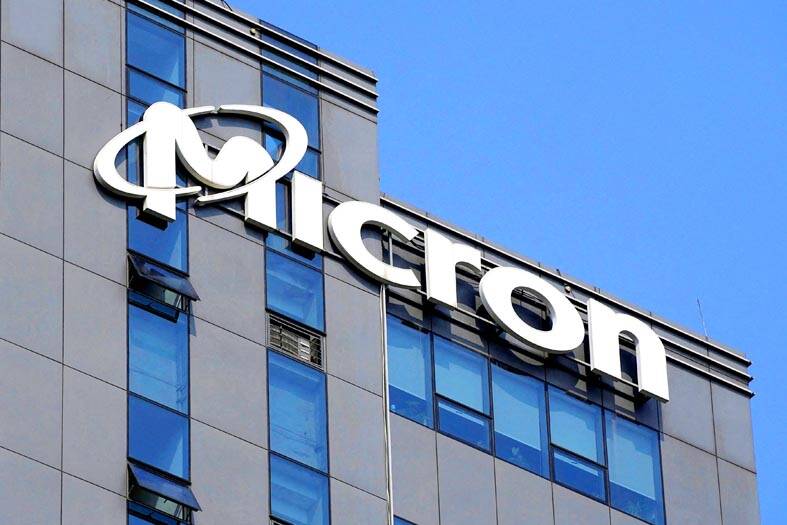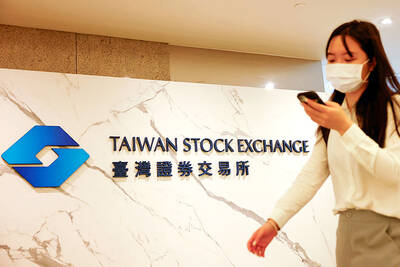The US plans to award Micron Technology Inc US$6.1 billion in grants and as much as US$7.5 billion in loans to help the memory-chip maker build new US factories, rounding out a slew of major federal awards for advanced semiconductor manufacturing.
Micron pledged to invest about US$125 billion to build four factories in New York state and one in Idaho.
The company has separately applied for federal funding to support a project in Virginia, documents filed last week showed.

Photo: Reuters
US President Joe Biden is traveling to Syracuse, New York, as part of the event and plans to discuss how his agenda is shoring up the economy.
It would still be months before Micron actually receives any of the funding from the 2022 Chips and Science Act, which set aside US$39 billion for grants and US$75 billion worth of loans to boost US chipmaking and reduce reliance on Asia. Preliminary agreements like the one Micron announced yesterday trigger a due-diligence stage, after which the money would be handed out over time in tranches tied to construction and production benchmarks.
“The US$6.1 billion will supercharge Micron to bring back leading-edge memory manufacturing to the US,” Senate Majority Leader Chuck Schumer of New York told reporters ahead of the announcement. “We cannot have these chips made overseas and let them be made by competitors like China.”
One plant that is already under construction in Boise would receive funding and be poised for production in 2026. Two more in the Syracuse area of New York state would be built and ready for manufacturing in 2028 and 2029. Micron also is planning two other facilities in New York that are not covered by the scope of yesterday’s preliminary agreement.
Computer memory is a vital part of everything from smartphones to supercomputers and works alongside processors made by companies such as Nvidia Corp and Intel Corp. The funding award guarantees that Micron would proceed with its first cutting-edge manufacturing expansion in the US in more than 20 years.
However, the expansion comes with risks for Micron. Memory chips have volatile prices because the components are built to industry specifications. That means they are interchangeable, resulting in a commodity-like market. Rapid swings between shortages and gluts have characterized Micron’s history and made sustained profitability difficult to achieve. It reported a net loss of more than US$5 billion last year — just a year after posting a huge profit.
US Secretary of Commerce Gina Raimondo previously said that advanced chipmakers had requested more than double the amount of grant money set aside for them. The department allocated about US$28 billion of the US$39 billion pool for top-of-the-line facilities.
The four main advanced manufacturers building in the US — Micron, Intel, Taiwan Semiconductor Manufacturing Co (台積電) and Samsung Electronics Co — are set to receive a combined US$27.6 billion in grants. The only other company that does such production, South Korea’s SK Hynix Inc, has committed to building a US packaging facility. That means the US would become the only country in the world with facilities run by all of the top manufacturers.
Micron’s projects are expected to generate 20,000 jobs spanning construction and manufacturing, the US Department of Commerce said. The company has also signed labor agreements with construction unions for its New York and Idaho sites, and its Chips Act grant sets aside US$40 million specifically for workforce training.

ADVANCED: Previously, Taiwanese chip companies were restricted from building overseas fabs with technology less than two generations behind domestic factories Taiwan Semiconductor Manufacturing Co (TSMC, 台積電), a major chip supplier to Nvidia Corp, would no longer be restricted from investing in next-generation 2-nanometer chip production in the US, the Ministry of Economic Affairs said yesterday. However, the ministry added that the world’s biggest contract chipmaker would not be making any reckless decisions, given the weight of its up to US$30 billion investment. To safeguard Taiwan’s chip technology advantages, the government has barred local chipmakers from making chips using more advanced technologies at their overseas factories, in China particularly. Chipmakers were previously only allowed to produce chips using less advanced technologies, specifically

The New Taiwan dollar is on the verge of overtaking the yuan as Asia’s best carry-trade target given its lower risk of interest-rate and currency volatility. A strategy of borrowing the New Taiwan dollar to invest in higher-yielding alternatives has generated the second-highest return over the past month among Asian currencies behind the yuan, based on the Sharpe ratio that measures risk-adjusted relative returns. The New Taiwan dollar may soon replace its Chinese peer as the region’s favored carry trade tool, analysts say, citing Beijing’s efforts to support the yuan that can create wild swings in borrowing costs. In contrast,

BRAVE NEW WORLD: Nvidia believes that AI would fuel a new industrial revolution and would ‘do whatever we can’ to guide US AI policy, CEO Jensen Huang said Nvidia Corp cofounder and chief executive officer Jensen Huang (黃仁勳) on Tuesday said he is ready to meet US president-elect Donald Trump and offer his help to the incoming administration. “I’d be delighted to go see him and congratulate him, and do whatever we can to make this administration succeed,” Huang said in an interview with Bloomberg Television, adding that he has not been invited to visit Trump’s home base at Mar-a-Lago in Florida yet. As head of the world’s most valuable chipmaker, Huang has an opportunity to help steer the administration’s artificial intelligence (AI) policy at a moment of rapid change.

TARIFF SURGE: The strong performance could be attributed to the growing artificial intelligence device market and mass orders ahead of potential US tariffs, analysts said The combined revenue of companies listed on the Taiwan Stock Exchange and the Taipei Exchange for the whole of last year totaled NT$44.66 trillion (US$1.35 trillion), up 12.8 percent year-on-year and hit a record high, data compiled by investment consulting firm CMoney showed on Saturday. The result came after listed firms reported a 23.92 percent annual increase in combined revenue for last month at NT$4.1 trillion, the second-highest for the month of December on record, and posted a 15.63 percent rise in combined revenue for the December quarter at NT$12.25 billion, the highest quarterly figure ever, the data showed. Analysts attributed the